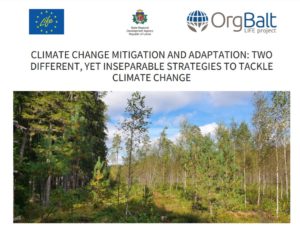LIFE OrgBalt has published an article “Climate change mitigation and adaptation: two different, yet inseparable strategies to tackle climate change“ [1]
READ THE FULL ARTICLE HERE [1]
In the light of the current human made climate crisis, it is crucial to employ several approaches to adjust to the impacts of climate change and to reduce the causes of climate change. This article will explain two strategies that are pursued globally – climate change mitigation and climate change adaptation. Within the LIFE OrgBalt project, experts and practitioners explore various practices for adaptation and mitigation in the agriculture and forestry sectors in the project regions.
| Mitigation – reducing climate change – involves reducing the flow of heat-trapping greenhouse gases into the atmosphere, either by reducing sources of these gases [2] or enhancing the “sinks” that accumulate and store these gases.[i] [3] |
| Adaptation – adapting to life in a changing climate – involves adjusting to actual or expected future climate and the consequenting environmental changes.[ii] [4] |
In order to achieve the Paris Agreement target of limiting global warming to well below 2, preferably to 1.5 degrees Celsius, compared to pre-industrial levels, an annual decline of greenhouse gas (GHG) emissions of 7.6% is needed between 2020 and 2030 globally[iii] [5].
Even if the mitigation efforts prove to be successful in reducing emissions, warming effects of the atmosphere do already and will in future impact the livelihood of our society. This is where climate change adaptation strategies come into play. As explained by Research Professor at the Natural Resources Institute Finland LUKE Raija Laiho, “adaptation means all actions that we can take to be prepared to face the consequences of the on-going change. How much adaptation is needed depends on how much and how fast we can mitigate”.
There is significant need for mitigation and adaptation activities in the Agriculture, Forestry and Other Land Use (AFOLU) sector. According to the IPCC, emissions from the AFOLU sector in the period 2007-2016 represented 23% of total net anthropogenic emissions of GHGs[iv] [6]. Actions in the AFOLU sector can bring real change to global and local mitigation and adaptation efforts.
Calculation of emissions is a complex task where LIFE OrgBalt aims to contribute with improving national GHG inventories. The national GHG inventories are crucial for a data-based evaluation and monitoring of the progress in reaching GHG reduction targets. However, the national inventories are based on estimations for GHG emission factors for each action in the sectors. The more and higher quality data becomes available, the more precise the factors and estimates will get.
What in practical terms do climate change mitigation and adaptation measures in land use mean?
LIFE OrgBalt surveyed project key stakeholders about the strategies for climate change mitigation and adaptation that are currently used in the agricultural and forestry sectors. The practitioners need credible information to choose the most efficient measures. As put by Riina Maruštšak, the Head of Environmental Policy at the Estonian Chamber of Agriculture and Commerce, “there are farmers who do not associate these practices with climate action as so far mainly water protection topics have been in focus regarding environmental protection in agriculture.” Some of the actions practiced in agriculture include precision farming, growing winter crops, and minimum tillage, according to Riina Maruštšak. In addition Liisa Toopakka, Conservation Expert of the Finnish Association for Nature Conservation, emphasises that it is crucial to stop the draining of new peatland areas, both in agriculture and forestry. Forestry practice choices, like maintaining continuous cover, increasing rotation length, and fertilising with ash, are mentioned by the practitioners in Finland.
Nerijus Kupstaitis, head of the Forest Policy Group of the Ministry of Environment of the Republic of Lithuania, states that currently the traditional forestry approaches for growing the so far justified tree species and forest types on nutrient-rich organic soils are used in Lithuania.
The LIFE OrgBalt project will demonstrate innovative practices to mitigate and adapt to climate change. In that way LIFE OrgBalt seeks to encourage practitioners to take steps towards climate neutral land use.
READ THE FULL ARTICLE HERE [1]
[i] [7] https://climate.nasa.gov/solutions/adaptation-mitigation/ [8]
[ii] [9] https://climate.nasa.gov/solutions/adaptation-mitigation/ [8]
[iii] [10] https://www.un.org/en/climatechange/science/key-findings [11]
[iv] [12] https://www.ipcc.ch/srccl/chapter/summary-for-policymakers/ [13]
